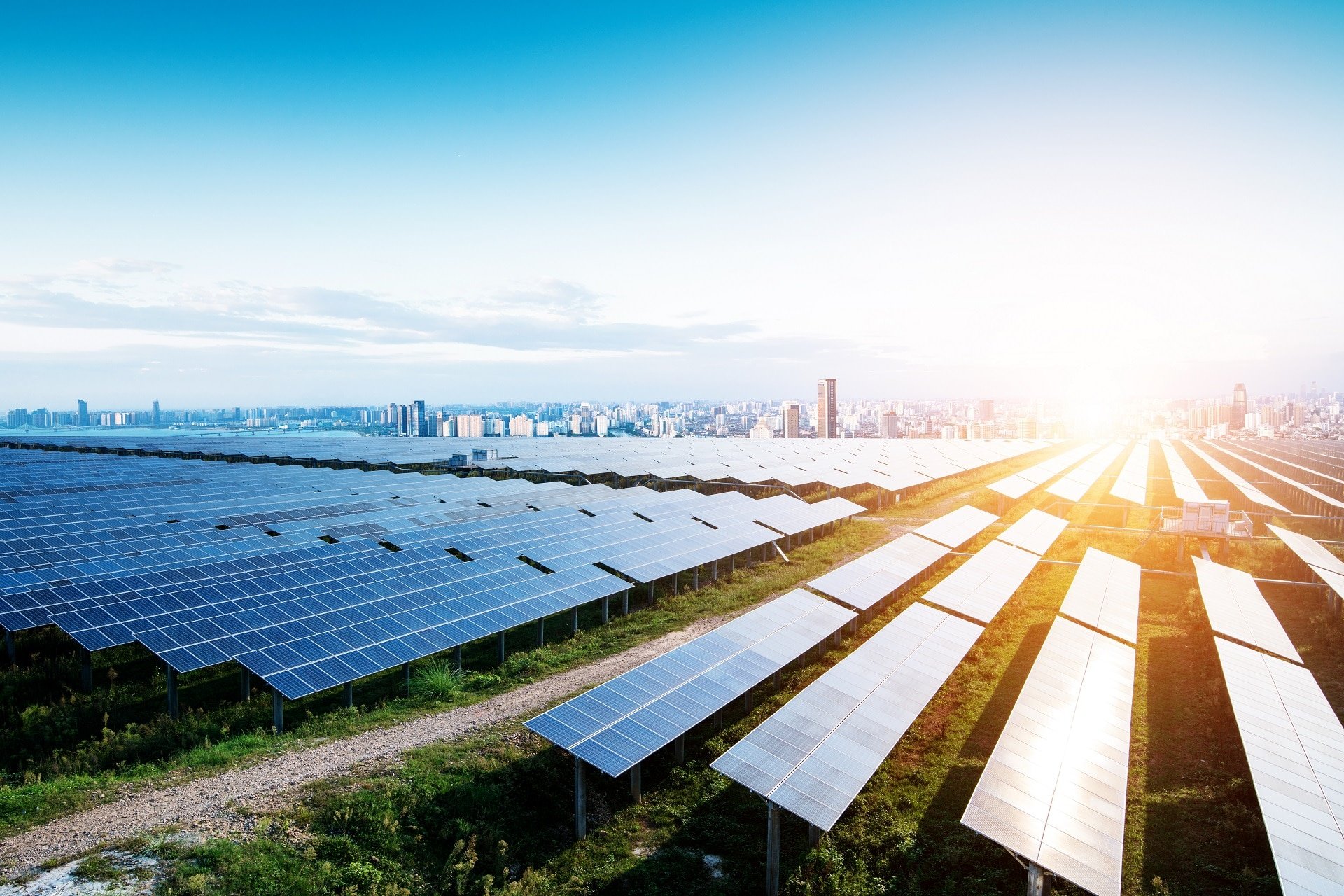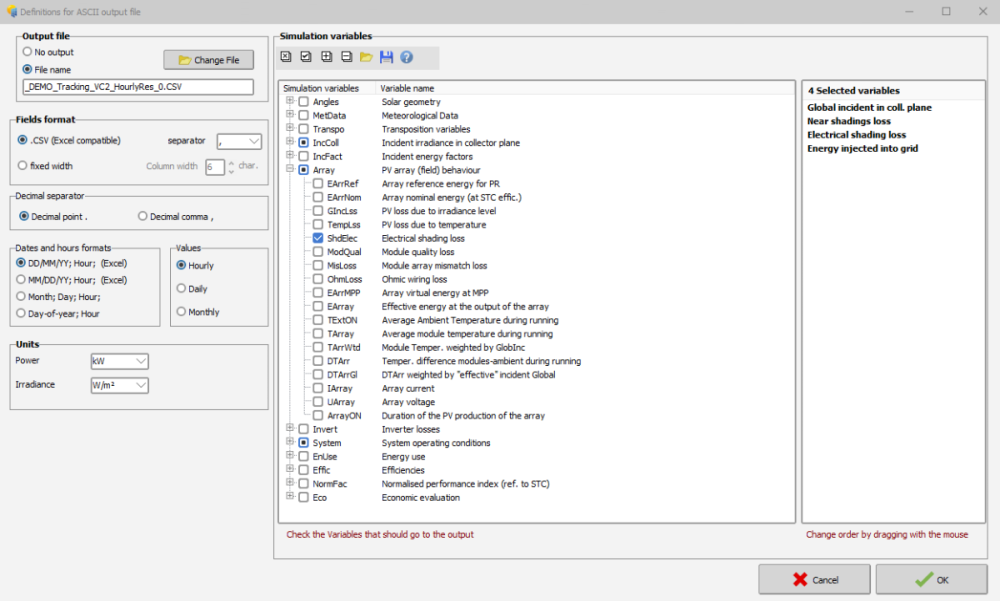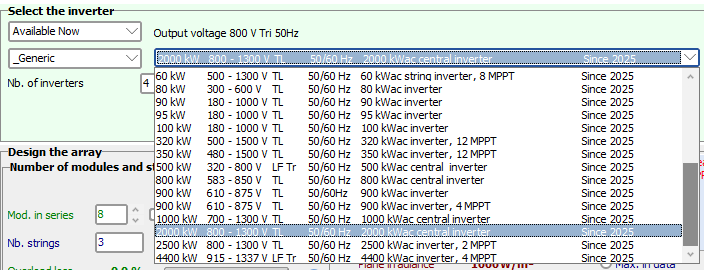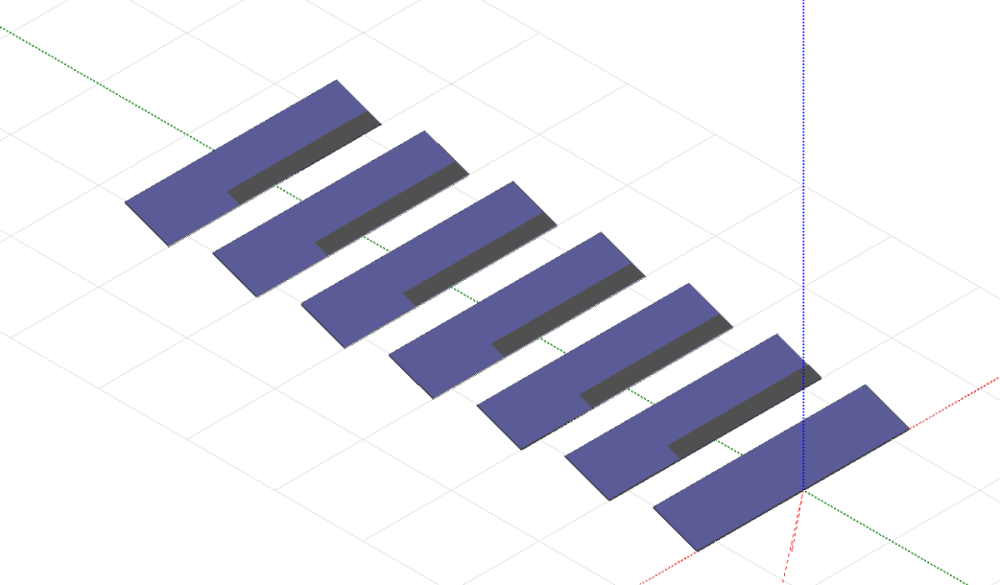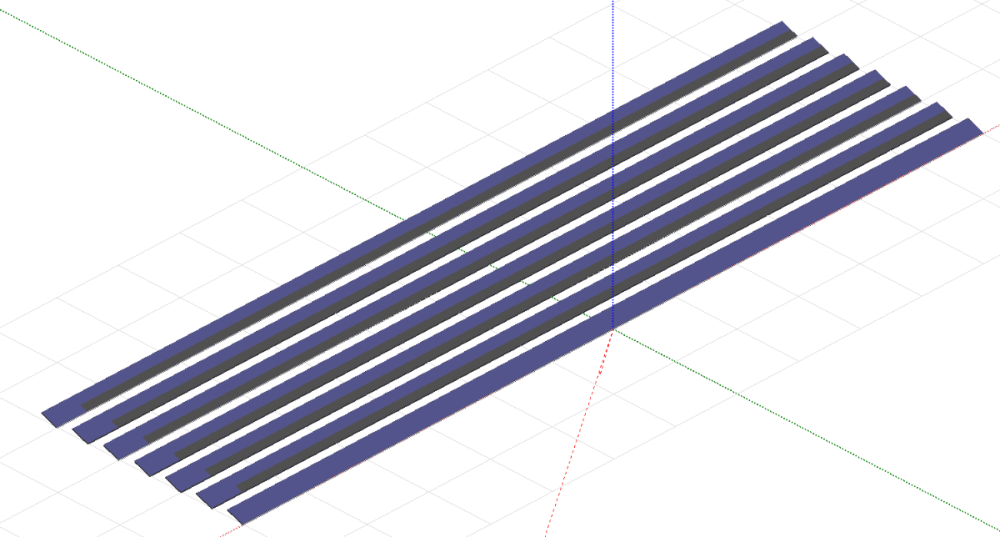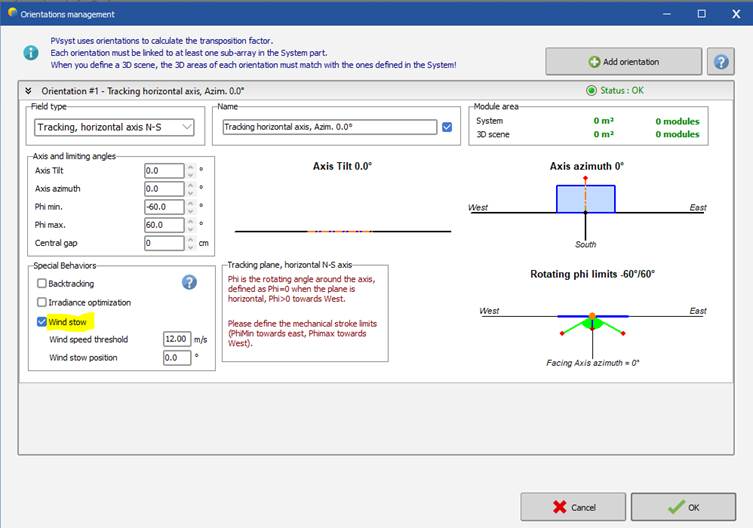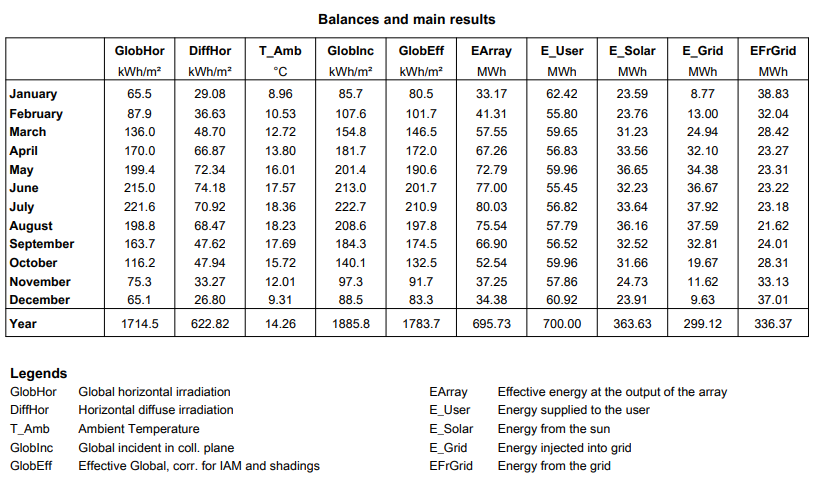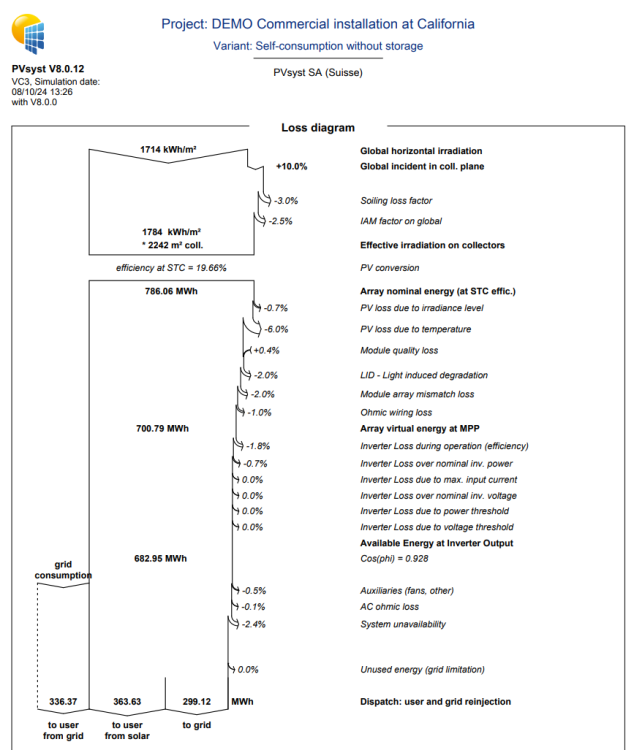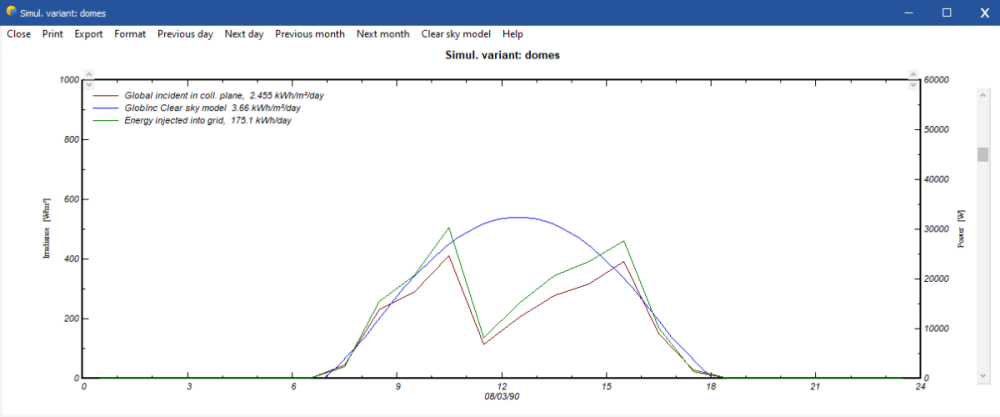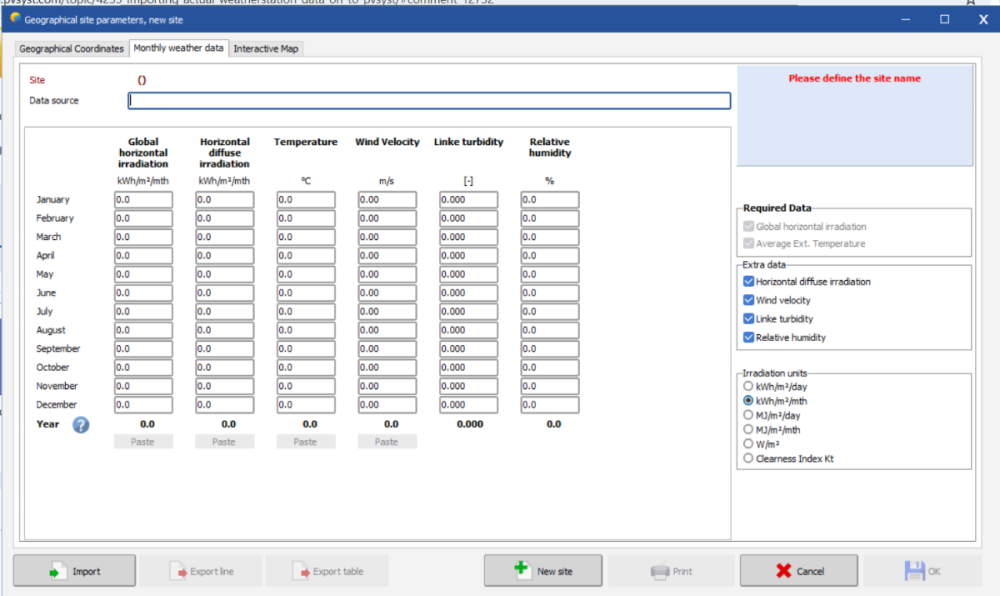-
Posts
310 -
Joined
-
Last visited
Everything posted by Linda Thoren
-
Hello, Indeed the workflow would be to precisely define the coordinates for where the site, define the MEF file and run the conversion of the data. If PVsyst suggest a time shift, go back to the MEF file and define the indicated time shift and run the conversion again. If the issue persists, please send your data to support@pvsyst.com and we can have a closer look.
-
Hi, you can export an Output File with any relevant parameters through the Advanced simulation window.
- 7 replies
-
- shadings
- shading scene
-
(and 1 more)
Tagged with:
-
The multi-MPPT feature and how to configure different sub-arrays to precisely define your system is explained in the following youtube tutorial:
-
Hi, For hourly estimation of both the production and the specific losses, you can export an Output File with any relevant parameters through the Advanced simulation window. From the hourly/daily values generated, you can do any analysis in an external tool such as excel.
- 7 replies
-
- shadings
- shading scene
-
(and 1 more)
Tagged with:
-
the idea is the same for the limitation of maximum current per MPPT. The graphics in the system window is an approximation, not considering the backside production, though the simulation will.
-
Hello, The values used in the system sizing serve only as a guideline and provide an order-of-magnitude estimate, considering only the initial front-side production (excluding for instance losses and rear-side generation). For an accurate assessment of overload losses, you should run a simulation.
-
Among the Generic inverter in the database, you can find examples of central inverters. Here you see that there are no MPPTs. By opening the .OND file, you find this information in the Additional parameters tab.
-
Indeed, the first row will not have any mutual shadings. For “unlimited” long tables, mutual shading can be applied uniformly across the entire row, allowing edge effects to be neglected. In the two images below, you can see an example, that for long tables, the impact of edge effects is limited to the lower-left corner and is therefore negligible. However, for shorter tables, this assumption becomes less valid.
-
Hello, In the database we unfortunately do not have a filter to sort out the central inverters from the string inverters. In PVsyst, the difference from a string inverter and a central inverter would be characterized by the fact that the central inverter do not have multiple MPPTs
-
Hello, PVsyst does not consider any loss due to tracking inaccuracy and there is no general “other losses” parameter, though you could possibly add such a loss as a “soiling loss” for instance. If wind velocity is available in the meteorological data, you can simulate wind stow behavior. You would define a wind speed threshold, and if the wind speed during a particular hour exceeds this threshold, the simulation would be done for the defined wind stow position for that hour. This would normally result in a less optimized tilt angle and thus less production, though it will not directly appear as a loss in the loss diagram.
-
In general, the denomination of a given time interval in PVsyst is always defined as the beginning of this interval. This is valid for hourly, daily or monthly values. For meteo data, the time stamp is the time interval over which the irradiance measurement (or any other value) is averaged. For example, the time stamp 11:00 corresponds to measurements averaged between 11:00 and 12:00. When using irradiance models, the solar geometry should be calculated for an "average" of the time interval. PVsyst uses the middle of this time interval (in the previous example 11:30). Different weather data providers have their own definition of the timestamp and thus will be adapted to match the one in PVsyst.
-
Hello, A floating system is rather similar to a conventional PV system. Following forum post describes how you can adapt your simulation to a floating PV system: To start a PVsyst project, we have several tutorials in PDF and on youtube: https://www.pvsyst.com/wp-content/pdf-tutorials/pvsyst-tutorial-v8-grid-connected-en.pdf
-
Hello, Yes, the zone tool will be improved in a future version. In the meantime, by defining a fixed tilted plane with the all the parameters you wish for your trackers (orientation, pitch, size etc.) and tick the option "Create tracking fields" (as you have done in image 4), the zone will be filled with trackers with the correct definition.
- 1 reply
-
- orientation
- 3d scene
-
(and 2 more)
Tagged with:
-
Hello Johann, The simulation and corresponding energy balance are calculated using hourly time steps. To determine how much of the generated solar energy can be self-consumed, the simulation must be run. For example, in the DEMO project “DEMO Commercial Installation at California” (VC3), the report shows: E_User: the total energy delivered to the user (reflecting the self-consumption profile), E_Solar: the portion of E_User that is covered by solar production, EFrGrid: the remaining energy that must be imported from the grid to meet the user's demand, E_Grid: any excess solar energy that is injected into the grid. These values are also illustrated in the annual loss diagram, giving a complete overview of the system’s performance over the year. Best regards
-

Daily generation profile Irregularities
Linda Thoren replied to JamesLenton's topic in Problems / Bugs
Indeed it seems a bit surprising that the global irradiance would be 0 for a few hours in the middle of the day, but indeed possible. Using another weather data provider, do you see similar drops in irradiance? If you import a weather file with missing data, these hours will be considered as 0 in PVsyst. -

Daily generation profile Irregularities
Linda Thoren replied to JamesLenton's topic in Problems / Bugs
Hello, To better understand the results, you can consider adding additional parameters—such as irradiance—to assess whether a drop in production is due to variations in weather data or other factors. In the Advanced Simulations, you also have the option to export hourly data as a .csv file, allowing for deeper analysis of any relevant simulation parameters. -
Dear Ihr, The Global horizontal irradiation is transformed to global incident in collector plane by using a transposition model. You can read more about the transposition model in the following PVsyst help page: https://www.pvsyst.com/help/physical-models-used/irradiation-models/transposition-model.html?h=transpositio The Global on collector plane from the Quick optimization box in the orientation window is based on the clear sky model at your site and is not the result of the simulation but serves as a quick optimization to get an order of magnitude of the irradiance in the collector plane according the chosen tilt and azimuth. The GlobInc in the report is the result of the simulation based on the hourly weather data.
-

PVGIS hava durumu verilerini getirme hatası
Linda Thoren replied to Hakan Öztürk's topic in Meteo data
Hello Hakan öztürk, Please note that this forum is in English. In December, PVGIS modified their format for the TMY output, which has affected the functionality of our API. The data reading was updated in version 8.0.6. Please update to a more reason PVsyst version and this should solve your issue. -
Hello! You should divide your 10 years of data into 10 different files, one for each year. Then you can generate a TMY weather filed based on these 10 individual year in the TMY generation tool. In your workspace, you find a template for the PVsyst standard file, double check comparing to this file that you are following the requirements. You can also import your file as a Custom file is you continue having issues with the known format.
-

Importing actual weatherstation data on to PVsyst
Linda Thoren replied to Sydwell's topic in Meteo data
Hello Kadi1, Indeed the simulation will be done for maximum a year, thus the weather data can not contain data for more than a year. The simulation will be done with hourly time steps, so to use the custom file you need to have hourly values. Do you have daily averages? You could possibly create monthly averages based on all the years of data that you avail, and create a synthetic data file based on the monthly averages. This can be done but creating a new site and fill in the Monthly weather data: -
Hello Marija, Indeed, the only possibility is to apply a grid limit for the full system. As you suggest, a workaround would be to create a variant for each sub-system and aggregate the results. I will note your use-case for possible future development of for instance having the possibility to define the limitation per sub-array (as for the ohmic losses for instance). Thank you reaching out

